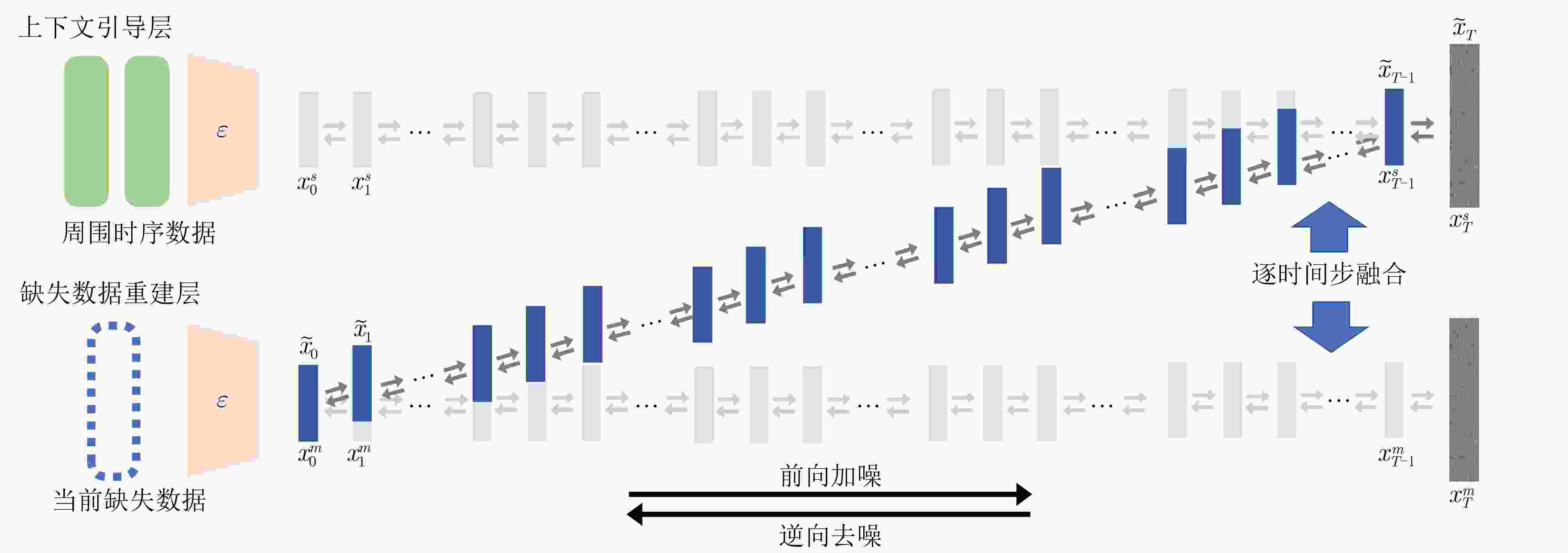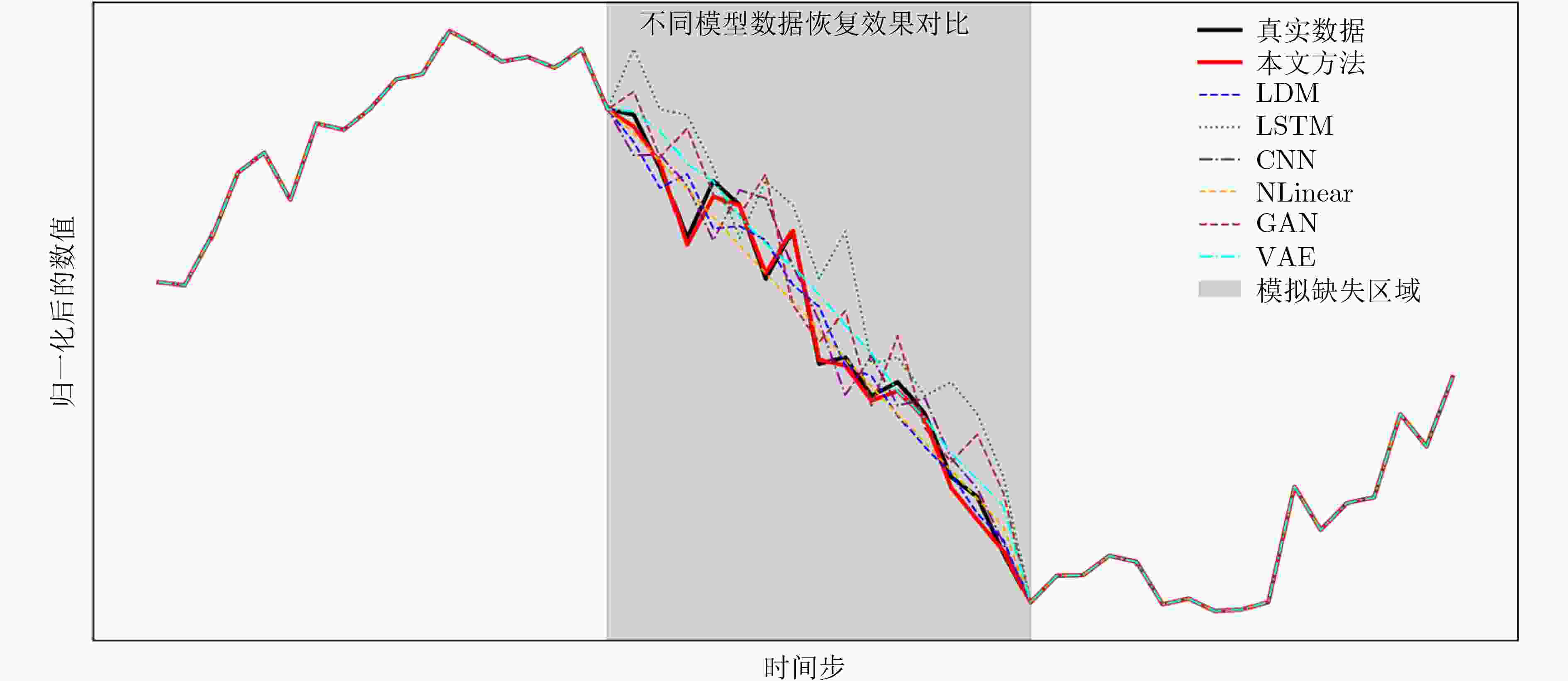Power Grid Data Recovery Method Driven by Temporal Composite Diffusion Networks
-
摘要: 电网作为连接电力传输与终端用户的重要枢纽,其数据的管理与分析在保障电网稳定性和提升供电质量方面扮演着举足轻重的角色。电网相关数据涵盖范围广泛,内容复杂,包括用户用电模式、气象条件、设备信息及营销数据等多个层面。这些多源异构数据在采集和传输过程中,常受到噪声信号等冗余信息的影响,容易出现数据缺失现象。数据不完整不仅使运行状态监测变得更加困难,也严重制约了故障诊断、健康评估及运维决策等关键工作的效率与准确性。为了提高电网数据的效用性,更好地利用其来保障电网稳定运行,该文提出一种基于扩散模型的电网数据恢复方法,通过独特设计的双层扩散流,能将时序序列嵌入为条件信息,大幅优化了扩散网络在电网场景下的表现。模型将输入的高斯噪声映射到缺失数据的目标分布空间,从而按照其原始分布规律恢复出缺失数据,增强了数据的可用性和价值。实验表明,与以往的方法相比,该方法能够达到领先的恢复效果。Abstract:
Objective Smart grid construction drives modern power systems, and distribution networks serve as the key interface between the main grid and end users. Their stability, power quality, and efficiency depend on accurate data management and analysis. Distribution networks generate large volumes of multi-source heterogeneous data that contain user consumption records, real-time meteorology, equipment status, and marketing information. These data streams often become incomplete during collection or transmission due to noise, sensor failures, equipment aging, or adverse weather. Missing data reduces the reliability of real-time monitoring and affects essential tasks such as load forecasting, fault diagnosis, health assessment, and operational decision making. Conventional approaches such as mean or regression imputation lack the capacity to maintain temporal dependencies. Generative models such as Generative Adversarial Networks (GANs) and Variational AutoEncoders (VAEs) do not represent the complex statistical characteristics of grid data with sufficient accuracy. This study proposes a diffusion model based data recovery method for distribution networks. The method is designed to reconstruct missing data, preserve semantic and statistical integrity, and enhance data utility to support smart grid stability and efficiency. Methods This paper proposes a power grid data augmentation method based on diffusion models. The core of the method is that input Gaussian noise is mapped to the target distribution space of the missing data so that the recovered data follows its original distribution characteristics. To reduce semantic discrepancy between the reconstructed data and the actual data, the method uses time series sequence embeddings as conditional information. This conditional input guides and improves the diffusion generation process so that the imputation remains consistent with the surrounding temporal context. Results and Discussions Experimental results show that the proposed diffusion model based data augmentation method achieves higher accuracy in recovering missing power grid data than conventional approaches. The performance demonstrates that the method improves the completeness and reliability of datasets that support analytical tasks and operational decision making in smart grids. Conclusions This study proposes and validates a diffusion model based data augmentation method designed to address data missingness in power distribution networks. Traditional restoration methods and generative models have difficulty capturing the temporal dependencies and complex distribution characteristics of grid data. The method presented here uses temporal sequence information as conditional guidance, which enables accurate imputation of missing values and preserves the semantic integrity and statistical consistency of the original data. By improving the accuracy of distribution network data recovery, the method provides a reliable approach for strengthening data quality and supports the stability and efficiency of smart grid operations. -
表 1 不同模型在各数据集上不同序列长度输入的MSE(越低越好)对比,加粗代表最佳
数据集 序列长度 NLinear CNN LSTM GAN VAE DDPM LDM 本文方法 ETTh1 96 0.32 0.29 0.27 0.24 0.21 0.21 0.18 0.16 192 0.36 0.32 0.29 0.27 0.25 0.23 0.21 0.19 ETTh2 96 0.27 0.25 0.23 0.21 0.19 0.18 0.16 0.15 192 0.31 0.28 0.26 0.24 0.22 0.2 0.18 0.17 ETTm1 96 0.295 0.27 0.25 0.23 0.21 0.19 0.18 0.16 192 0.31 0.28 0.26 0.24 0.22 0.20 0.19 0.17 ETTm2 96 0.26 0.24 0.22 0.21 0.19 0.18 0.16 0.15 192 0.28 0.26 0.24 0.22 0.20 0.19 0.17 0.16 Electricity 96 0.19 0.18 0.16 0.15 0.13 0.12 0.11 0.09 192 0.21 0.19 0.18 0.16 0.15 0.13 0.12 0.11 表 2 不同模型在各数据集上不同序列长度输入的MAE(越低越好)对比
数据集 序列长度 NLinear CNN LSTM GAN VAE DDPM LDM 本文方法 ETTh1 96 0.43 0.41 0.39 0.37 0.35 0.34 0.32 0.31 192 0.46 0.43 0.41 0.39 0.37 0.36 0.34 0.32 ETTh2 96 0.38 0.36 0.34 0.33 0.32 0.30 0.29 0.28 192 0.42 0.39 0.37 0.36 0.34 0.33 0.31 0.28 ETTm1 96 0.39 0.37 0.35 0.33 0.32 0.30 0.29 0.27 192 0.41 0.38 0.36 0.35 0.33 0.31 0.30 0.28 ETTm2 96 0.35 0.33 0.32 0.31 0.29 0.28 0.26 0.25 192 0.37 0.35 0.34 0.32 0.31 0.29 0.28 0.26 Electricity 96 0.27 0.25 0.24 0.23 0.215 0.20 0.19 0.17 192 0.28 0.27 0.25 0.24 0.22 0.21 0.19 0.18 -
[1] 秀春男. 张家口公司 解锁智慧电网运维密码[J]. 华北电业, 2025(2): 12–13.XIU Chunnan. Zhangjiakou Company unlocks the code of smart grid operation and maintenance[J]. North China Power, 2025(2): 12–13. [2] 马恒瑞, 袁傲添, 王波, 等. 基于深度学习的负荷预测研究综述与展望[J]. 高电压技术, 2025, 51(3): 1233-1250. doi: 10.13336/j.1003-6520.hve.20241558.MA Huanrui, YUAN Aotian, WANG Bo, et al. Review and Prospect of Load Forecasting Based on Deep Learning[J]. High Voltage Engineering, 2025, 51(3): 1233-1250. doi: 10.13336/j.1003-6520.hve.20241558. [3] 李欣, 吴凌霄, 李新宇, 等. 基于缺失数据插补和改进集成策略的电力系统暂态稳定评估[J]. 电力系统及其自动化学报, 2025, 37(8): 38–48. doi: 10.19635/j.cnki.csu-epsa.001525.LI Xin, WU Lingxiao, LI Xinyu, et al. Transient stability assessment of power system based on missing data imputation and improved ensemble strategy[J]. Proceedings of the CSU-EPSA, 2025, 37(8): 38–48. doi: 10.19635/j.cnki.csu-epsa.001525. [4] 钟尧, 刘清蝉, 李昕泓, 等. 计及非负和低秩特性的用电数据缺失值插补[J]. 重庆大学学报, 2025, 48(9): 1–11. doi: 10.11835/j.issn.1000-582X.2024.214.ZHONG Yao, LIU Qingchan, LI Xinhong, et al. Complete electricity data reconstruction based on weighted nonnegative matrix factorization[J]. Journal of Chongqing University, 2025, 48(9): 1–11. doi: 10.11835/j.issn.1000-582X.2024.214. [5] 马燕玲. 基于线性回归法的电力计量数据缺失重构研究[J]. 电气技术与经济, 2025(2): 46–47, 54. doi: 10.3969/j.issn.1673-8845.2025.02.016.MA Yanling. Research on reconstruction of missing electric energy metering data based on linear regression method[J]. Electrical Equipment and Economy, 2025(2): 46–47, 54. doi: 10.3969/j.issn.1673-8845.2025.02.016. [6] YANG Ling, ZHANG Zhilong, SONG Yang, et al. Diffusion models: A comprehensive survey of methods and applications[J]. ACM Computing Surveys, 2024, 56(7): 105. doi: 10.1145/3626235. [7] LUO C. Understanding diffusion models: A unified perspective[Z]. arXiv preprint arXiv: 2208.11970, 2022. doi: 10.48550/arXiv.2208.11970. [8] 郑骁麟, 王天昊, 王凯奇, 等. 配电系统伪量测数据增强方法[J/OL]. 电力系统及其自动化学报, 1–10. https://doi.org/10.19635/j.cnki.csu-epsa.001607, 2025.ZHENG Xiaolin, WANG Tianhao, WANG Kaiqi, et al. Data enhancement of pseudo-measurement in power distribution system[J/OL]. Proceedings of the CSU-EPSA, 1–10. https://doi.org/10.19635/j.cnki.csu-epsa.001607, 2025. [9] 庞传军, 张波, 余建明. 基于LSTM循环神经网络的短期电力负荷预测[J]. 电力工程技术, 2021, 40(1): 175–180, 194. doi: 10.12158/j.2096-3203.2021.01.025.PANG Chuanjun, ZHANG Bo, and YU Jianming. Short-term power load forecasting based on LSTM recurrent neural network[J]. Electric Power Engineering Technology, 2021, 40(1): 175–180, 194. doi: 10.12158/j.2096-3203.2021.01.025. [10] 雷傲宇, 高永强, 王嘉琦, 等. 基于多测点数据相关性的PMU量测谐波数据缺失填补方法[J/OL]. 南方电网技术, 1–9. http://kns.cnki.net/kcms/detail/44.1643.tk.20250421.1656.004.html, 2025.LEI Aoyu, GAO Yongqiang, WANG Jiaqi, et al. Method for filling harmonic data missing in PMU measurement based on the correlation of multi-measurement point data[J/OL]. Southern Power System Technology, 1–9. http://kns.cnki.net/kcms/detail/44.1643.tk.20250421.1656.004.html, 2025. [11] HO J, JAIN A, and ABBEEL P. Denoising diffusion probabilistic models[C]. Proceedings of the 34th International Conference on Neural Information Processing Systems, Vancouver, Canada, 2020: 574. [12] SONG Yang, SOHL-DICKSTEIN J, KINGMA D P, et al. Score-based generative modeling through stochastic differential equations[C]. Proceedings of the 9th International Conference on Learning Representations, Vienna, Austria, 2021: 1–35. [13] SONG Yang, DURKAN C, MURRAY I, et al. Maximum likelihood training of score-based diffusion models[C]. Proceedings of the 35th International Conference on Neural Information Processing Systems, 2021: 109. [14] NICHOL A Q and DHARIWAL P. Improved denoising diffusion probabilistic models[C]. Proceedings of the 38th International Conference on Machine Learning, 2021: 8162–8171. [15] KARRAS T, AITTALA M, AILA T, et al. Elucidating the design space of diffusion-based generative models[C]. Proceedings of the 36th International Conference on Neural Information Processing Systems, New Orleans, USA, 2022: 1926. [16] ROMBACH R, BLATTMANN A, LORENZ D, et al. High-resolution image synthesis with latent diffusion models[C]. Proceedings of the IEEE/CVF Conference on Computer Vision and Pattern Recognition, New Orleans, USA, 2022: 10674–10685. doi: 10.1109/CVPR52688.2022.01042. [17] TASHIRO Y, SONG Jiaming, SONG Yang, et al. CSDI: Conditional score-based diffusion models for probabilistic time series imputation[C]. Proceedings of the 35th International Conference on Neural Information Processing Systems, 2021: 1900. [18] ALCARAZ J M L and STRODTHOFF N. Diffusion-based time series imputation and forecasting with structured state space models[Z]. arXiv preprint arXiv: 2208.09399, 2022. doi: 10.48550/arXiv.2208.09399. [19] ZHOU Haoyi, ZHANG Shanghang, PENG Jieqi, et al. Informer: Beyond efficient transformer for long sequence time-series forecasting[C]. Proceedings of the 35th AAAI Conference on Artificial Intelligence, Virtual Conference, 2021: 11106–11115. doi: 10.1609/aaai.v35i12.17325. [20] HEBRAIL G and BERARD A. Individual household electric power consumption[EB/OL]. https://doi.org/10.24432/C58K54, 2006. [21] ZENG Ailing, CHEN Muxi, ZHANG Lei, et al. Are transformers effective for time series forecasting?[C]. Proceedings of the 37th AAAI Conference on Artificial Intelligence, Washington, USA, 2023: 11121–11128. doi: 10.1609/aaai.v37i9.26317. [22] BAI Shaojie, KOLTER J Z, and KOLTUN V. An empirical evaluation of generic convolutional and recurrent networks for sequence modeling[Z]. arXiv preprint arXiv: 1803.01271, 2018. doi: 10.48550/arXiv.1803.01271. [23] GUPTA P, MEHLAWAT M K, and KHAN A Z. Multi-period portfolio optimization using coherent fuzzy numbers in a credibilistic environment[J]. Expert Systems with Applications, 2021, 167: 114135. doi: 10.1016/j.eswa.2020.114135. [24] GOODFELLOW I J, POUGET-ABADIE J, MIRZA M, et al. Generative adversarial nets[C]. Proceedings of the 28th International Conference on Neural Information Processing Systems, Montreal, Canada, 2014: 2672–2680. [25] KINGMA D P and WELLING M. Auto-encoding variational bayes[C]. Proceedings of the 2nd International Conference on Learning Representations, Banff, Canada, 2014. [26] CHEN Peng, ZHANG Yingying, CHENG Yunyao, et al. Pathformer: Multi-scale transformers with adaptive pathways for time series forecasting[C]. Proceedings of the 12th International Conference on Learning Representations, Vienna, Austria, 2024. -






 下载:
下载:




 下载:
下载:
